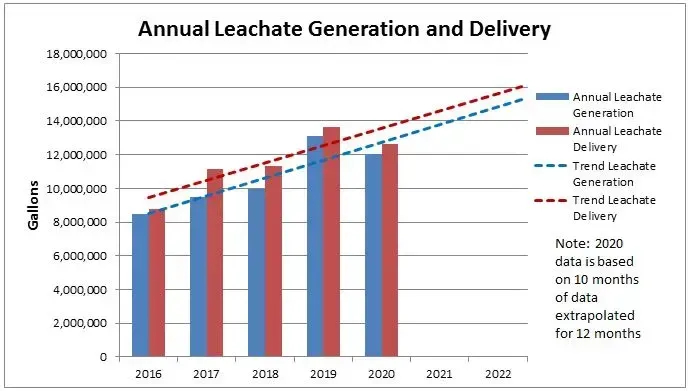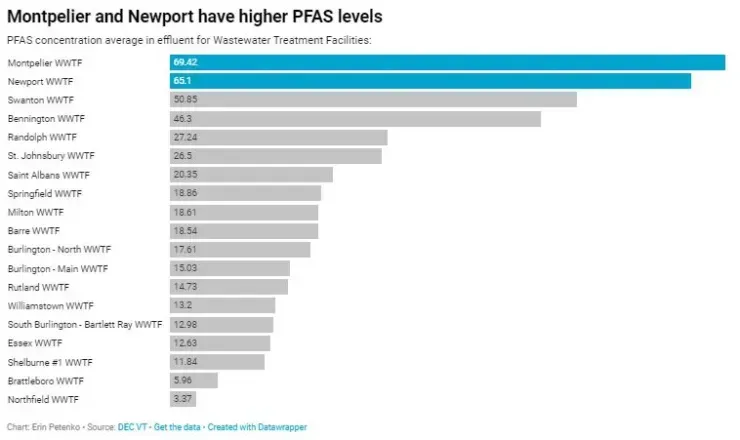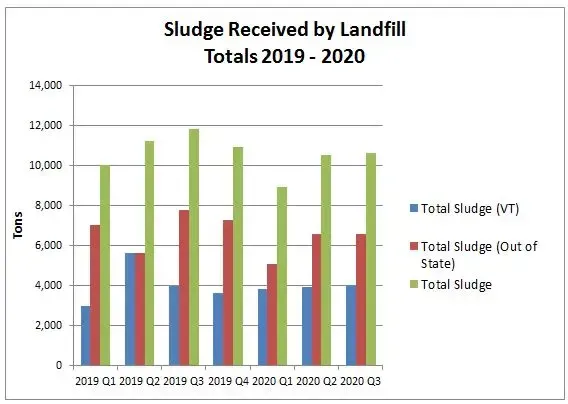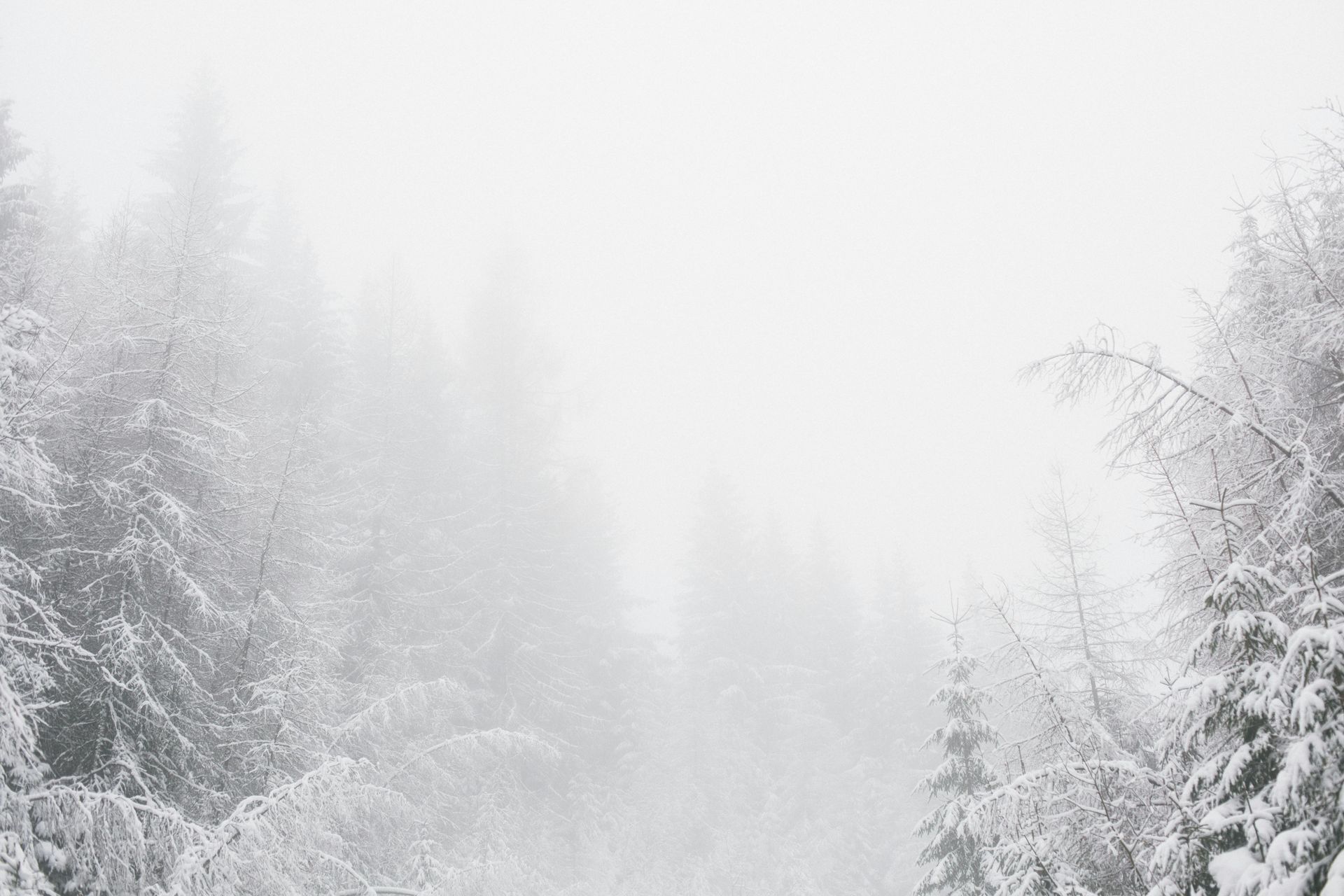LANDFILL LEACHATE EXPLAINED
What is Landfill Leachate?
LANDFILL
LEACHATE
What is landfill leachate?
Landfill Leachate is a highly toxic liquid that drains or ‘leaches’ from landfills. It is created by the decomposition of waste materials and its volume is increased dramatically by rain and melting ice and snow. Leachate contains high concentrations of extremely toxic chemicals, including PFAS, which have been shown to cause cancer, birth defects and other serious problems in humans and wildlife.
How many gallons of leachate does the landfill produce?
In 2019 over 13 MILLION GALLONS of leachate were produced by the landfill.

Data compiled from Monthly Reports provided by the Coventry landfill (NEWSVT) to comply with Condition 76 of the landfill permit
What happens to all that landfill leachate?
The leachate is collected at the landfill, then pumped into trucks and transported to wastewater treatment facilities. Currently the leachate is being delivered to the wastewater facilities in Montpelier, Vermont and Plattsburg, New York where it is disposed. Toxic PFAS (and other toxic chemicals i.e. Volatile Organic Compounds, Phenols to name a couple) ARE NOT removed and those toxic chemicals are discharged into the Winooski and Saranac rivers which flow into Lake Champlain. Until November of 2019, the Newport Vermont wastewater treatment plant received up to 15,000 gallons/day of landfill leachate. The toxic laden effluent from the wastewater treatment plant was discharged into the Clyde River, which flows into Lake Memphremagog.
Is landfill leachate poisoning our environment? Our drinking water? It is possible.
What toxic chemicals are present in the leachate?
PFAS, VOCs (volatile organic compounds) and phenols, to name a few. PFAS chemical are often referred to as the “forever” chemicals.
What are PFAS chemicals and why are they harmful?
Per- and polyfluoroalkyl substances (PFAS) are a group of man-made chemicals. According to the U.S. Environmental Protection Agency (EPA), PFOA and PFOS, the most studied of these chemicals are easily absorbed, take many years to break down in the human body and environment and rapidly accumulate to lasting dangerous levels with continued exposure. Health risk of PFAS include birth and development abnormalities, kidney cancer and testicular cancer, to name only a few. Read more >
What products that end up as trash contain PFAS?
A partial list is shown below:
– Non-stick cookware (Teflon, SilverStone, and more)
– Rain repellent clothing (GORE-TEX is one example)
– Soil resistant carpet and furniture upholstery (Stainmaster, Scotchgard, and more)
– Mattresses
– Food Packaging (Fast food paper wrappings, pizza box liners, and more)
Can PFAS be removed from the leachate?
There are some new technologies that can be used to remove PFAS, but currently wastewater treatment facilities DO NOT REMOVE PFAS! Instead the toxic chemicals are discharged into our waterways and flow into our lakes.
Here is how the toxins from landfill leachate can pollute our environment and our drinking water.
The EPA has stated that eventually all landfill liners will leak, which would allow toxins to pollute the groundwater around the landfill. Even if they don’t leak, the toxins can enter our environment in other ways, as discussed below.
Waste Water Treatment Discharge
The leachate that is collected at the landfill is disposed of in wastewater treatment plants.
This process does not remove the toxic chemicals, does not remove PFAS. The effluent water from the wastewater treatment plants is discharged into a river. Currently two plants are receiving the Coventry landfill’s leachate. Montpelier Vermont discharges this polluted water into the Winooski River, and Plattsburg NY discharges it into the Saranac River, both flowing into Lake Champlain. As noted in the chart below, the two Vermont wastewater treatment facilities that were receiving landfill leachate at the time, Montpelier and Newport had the highest concentrations of PFAS.

As posted in VT Digger 2/5/2020, “High readings for PFAS found in Montpelier and Newport wastewater plants”, by Elizabeth Gribkoff
Sludge
An end product of waste water treatment is sludge. This is the solid mass that is left after the wastewater is treated at a wastewater treatment plant. This sludge also contains PFAS chemicals. When this sludge is used to produce “bio-solids” or “organics”, it is often used as fertilizer and is spread on Vermont’s agricultural fields. Recent findings at a dairy farm in Maine have shown that this can actually poison our cows and our milk. Is Vermont- grown food and milk at risk? At this point no one knows.

Note the amount of sludge accepted from out of state.
Rain & Snow
Heavy rain and snow can degrade the soils covering the landfilled waste, including sludge, and leachate can “break out” through the cover soils and flow down the slope and into the ground. Areas near landfills have a greater possibility of groundwater contamination because of the potential pollution source of leachate originating from the nearby site. Such contamination of groundwater resources poses a substantial risk to local resource users and to the natural environment. The landfill in Coventry Vermont is located in the watershed of Lake Memphremagog, in the middle of several wetlands, with the Barton and Black Rivers on either side. There is a great potential for groundwater pollution, and the extreme storms that are the result of climate change make the situation much worse.
